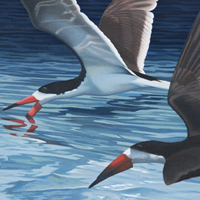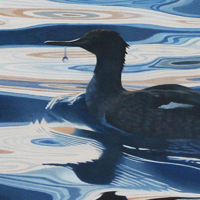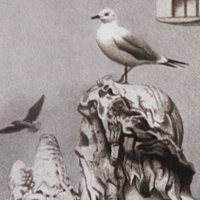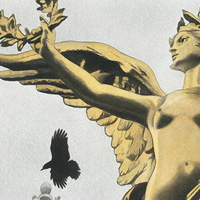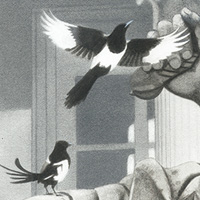Autobiography
At roughly the same time I had chosen to study illustration at California State University at Long Beach, I began a part time positon as a graphic designer with the City of Cypress. While graphic design has always been easy for me, I'd never planned to stay in it. But when my interests in painting and environmental education exploded, having a job creating art that would support me whether my other ventures were lucrative or not (and they have not been) turned out to be something to be embraced. I have been with Cypress ever since. When I began working in graphics, everthing was done with rapidograph pens, exacto knives, rubber cement, galleys from typesetters, etc. This method had been laborious, but it taught me attention to detail. The transition to electronic design applications in the early 90s had been both welcome and challenging, but it vastly simplified designing, and I can now no longer imagine creating graphic art without a computer. I've grown to feel that graphic arts and painting are totally inseparable for me. They contribute so much to one another. My sense for designing a 2-D space, the desire for visual variety in all of my work stem from this daily interaction.
EDUCATION & ENVIRONMENTAL AWAKENING
My goal when I started college and working as a graphic artist was to be a freelance illustrator. Since I was employed as a graphic artist, I had the luxury of experimenting, of taking the time to find my voice as an artist as well as a human being. I had always been able to draw whatever was in front of me; the challenge was to be able find the subject matter I felt passionate about. I could draw people, inanimate objects, landscapes, etc. quite well, but it took a while to find the things that really turned me on. I found much joy and ease in those early years of experimenting with different media--oils, acrylics, sculpting, printmaking--with the exception of watercolor. That was where I felt over-matched. Because I struggled with watercolor longer than other media, and then once I discovered I could make it do many other things besides the wet look most often associated with watercolor, I became hooked on its simplicity and immediacy. It also complimented my love for strong drawing based on observation. It took several years, but I grew into its demands on the integrity of the drawing and composition, and on the color and light.
One day in early 1982, while in the midst of my Bacherlor of Fine Arts studies in illustration studies at Cal State Long Beach, I went for a walk in an undeveloped corner of southeast Long Beach. Never quite sure where the man-made ended and the natural began, I literally stumbled off the landfill and found a small tendril of ocean and a number of birds that I hadn't thought existed in Southern California. It was at that moment--standing in the mud and small marsh plants, seeing birds I knew only from the Giant Golden book of Birds, surrounded by marinas, shopping malls, oil wells and a monolithic power plant--that my childhood fascinations returned. My desire to understand California's natural history and the bigger picture of global ecology awakened. That particular tendril of ocean (which is called Los Cerritos wetlands), I soon learned, was part of a once vast estuary that was dredged and filled and covered with city, a fate to which all of California's wetlands have succumbed to varying degrees
Later that year I made my first trips to the coastal saltwater wetlands at Bolsa Chica and Upper Newport Bay. Something was ignited in my heart--or reignited. At first I felt a great deal of anger at the destruction of natural habitat strictly to serve the greed and hedonism of our grossly materialistic culture. Then I got busy. By the time I completed the Bachelor of Fine Arts in Illustration program in 1984, I knew that whatever plans I had for being a freelance illustrator had to shift with this uncontrollable desire to paint birds. Perhaps not the smartest of career moves, but something else was happening I could not put my finger on. I did not know it at that time, but I was well on the way to a greater awakening.
Coastal saltwater wetlands are, along with rainforests, the most biologically productive ecosystems on the planet. They are also fragile, easily ignored and frequently a coveted place to cover with marinas or overpriced oceanfront real estate. Well over ten thousand acres of coastal wetlands existed in Los Angeles and Orange Counties in 1900. When I started studying them in the mid 80's, there were less than a few thousand acres, most of them threatened by development. So I photographed and I painted. I took some classes about the history and ecology of the Bolsa Chica wetlands at Coastline College. Bolsa Chica is the largest remaining coastal saltwater wetland habitat in Southern California. Although Bolsa Chica and Upper Newport Bay had been degraded over the last hundred years by farming, oil wells and poorly planned development of suburbia, it is still possible--especially when flocks of shorebirds or terns or ducks are present--to get a sense of what these wetlands might have been like before Europeans arrived.
I then returned to Cal State Long Beach to sharpen my focus on my new-found passion. Through my paintings, I wanted to show what was being lost. I created some strong editorial pieces, yet that was not a feeling I could sustain for a prolonged period. So I made a decision at that time to avoid preachiness, and learned to get my feelings for nature - my love of the beauty, joy and freedom that stirred my heart - on to paper. Not long before I started work on my Master of Fine Arts project in 1988, I began regularly donating artwork to the Amigos de Bolsa Chica. The Amigos was at that time a non-profit political lobbying organization whose mission was to preserve and restore the ecosystem threatened with development. This seemed to be the most logical thing to do, given that I still felt too angry, too at odds with the world to be an educator or scientist.
Painting what I saw at the Ecological Reserves at Bolsa Chica and Upper Newport Bay was the basis for my M.F.A. which I completed in 1993. I was finding a way to synthesize my enthusiasm for painting with my respect for science and the joy and serenity I derive from observing and appreciating nature, especially birds. Since then it has become a template for the way I strive to observe and understand everything that happens in my "backyard" to the greatest extent I can.
In the spring of 2000, I was honored to be asked to join the Board of Directors of the Bolsa Chica Foundation, an arm of the Amigos de Bolsa Chica (www.amigosdebolsachica.org) who primary educational program was conducting highly informed tours of the Bolsa Chica. For the first year or so, I just watched and listened. These people had been instrumental - and succussful - at saving all but a tiny fraction of Bolsa Chica from development; they were my heroes. It didn't take too long before I was comfortable collaborating on ideas to help educate people about the importance of the Bolsa Chica wetlands and California's coastal wetlands in general. At the beginning of 2004, I was appointed Chair of the Bolsa Chica Foundation.
Shortly thereafter, the Amigos de Bolsa Chica, which had been a 501(c)4 political lobbying non-profit, decided it's political lobbying days on behalf of the Bolsa Chica wetlands were winding down, and voted to merge with the Bolsa Chica Foundation, which was a 501(c)3 educational non-profit. In 2005, I became interim President of the Amigos de Bolsa Chica while we transitioned from the 501(c)4 to the 501(c)3. This took many months of creating new by-laws, filing with the Secretary of State, the Attorney General and the IRS, and reorganizing our goals and objectives in general. In 2006, the IRS granted Amigos de Bolsa Chica a non-profit foundation status, and I was elected President. Providing education about this vital ecosystem is now the main focus of the organization. On August 24, 2006, a 3 year, major multi-agency, multi-million dollar restoration of the Bolsa Chica wetlands was completed, and the ocean flowed once again into parts of the wetlands that had not felt the tides in over 100 years. It was an exciting time to lead this group. My presidency ended in 2007 and I remain on the Board of Directors assisting with a wide variety of exciting educational projects.
Never content to paint the same thing in the same way over and over, between 1999 and 2003, I began pushing watercolor and ink in search of new things to say about birds and landscapes. Some of my simplest and strongest work was the result of this restlessness. Yet there was a tension of wanting to say something new, to paint in a different way, to express something I had not expressed before and simply to be a better painter. It finally became too strong. I reached a point where, after 20 years of painting exclusively with water media, I felt I had nothing new to say. It was time for a another change.
After several years of contemplation, after two months of staring at a blank canvas, I finally picked up my 22 year old tubes of oil paint and started using them again in July of 2004. Much to my amazement, they were still ready and waiting. It has been a great pleasure, as if everything I've learned from watercolor brought me to this point. Drama and atmosphere are probably two of the most important things to me in a painting, and capturing them with watercolor or ink had always been challenging. Probably because of all that I've learned with watercolor, drama and atmosphere seem to flow automatically in oil for me. Color and the absence of color are also extremely important to me, as are the patterns and shapes I find in nature that tend to be more about abstraction and less about realism. My use of oils has been shaped by what watercolor taught me, so while the subject matter has not changed, how I approach it has.
After a long illness, my mother passed away in 1992. Three years later, my partner of 15 years died from a series of long illnesses brought on by HIV. This should have been a joyous time in my life: completing my M.F.A. and beginning exhibiting my work. Yet by the end of 1996, I was not happy with the way I was fitting into the world on all levels. A friend introduced me to a spiritual teacher named Anandi Devi.
I'd never really considered myself to be on a spiritual path, but there were some unusual synchronicities surrounding this introduction. From the moment I met Anandi, I had complete faith and trust that this humble woman would heal my heart and change my life. Not coincidentally, it was also around this time that I began another committed relationship that has thrived to this day: after 12 years together, Brian and I were married in an intimate ceremony attended by close family members in 2008.
To make a very long story very short, Anandi has shown me the way to true and lasting freedom and happiness. With a highly developed and focused gift of unconditional love, she teaches how to embrace, forgive and let go of negative patterns and thought forms. Anandi's spiritual psychology has turned out to be just what I have longed for all of my life, and studying with an enlightened being has been the most challenging and rewarding experience of my life. It is constant work to follow her teachings, but the rewards are infinite.
One of the greatest doorways on this path was opened when she explained, "We change the world by changing ourselves, changing our hearts, our minds and our emotions. All our thoughts and all our feelings are felt everywhere. There are no separate minds or separate hearts. Our consciousness, our hearts effect the entire planet, all of humanity, all of life. When you're truly happy, you can't hurt anyone or anything."
Anandi's teachings are at once highly contemporary and ancient. They are simple yet quite difficult to maintain in a world filled with distractions. They are not about processing or analyzing what's buried in the mind. That's really just entertainment, or torture, and not a solution. This path is about going deep inside the heart and into the soul's desire to have union with divinity, to return to a state of harmony with all of humanity and all life on this planet. It is about understanding that God is love and consciousness, and love and consciousness are God. With so much of humanity in the grips of negativity, of fear, doubt, anger, numbness, guilt and repression, the simple, if not always easy, lessons for healing the heart are very practical remedies for an ancient problem.
My concerns for birds, wetlands, the health of the earth and my creativity are the definition of my life's purpose. Now I understand that all that matters is what's in my heart. Everything else is a distraction, the pain of the illusion of being separate from God, from Love, from each other and from all life on the planet. I know now I can't change much, if anything, beyond my own heart, but the effect that alone can have on this planet is not to be underestimated. While I will always paint, create and express my concerns, my priorities are to continue freeing myself from the pain and illusion of separation, and to serve in what ever ways are the highest for my gifts, creative and otherwise.
